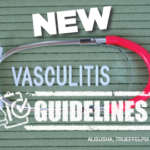Dr. Caplan thinks it is a mistake to conclude that lack of level A evidence on a given question should imply that guidelines are not desirable and should notIdeally, the process of guideline formation itself could be used to help shape the research agenda, & guidelines do usually contain recommendations for future research. be attempted. “That’s philosophically at odds with feedback we’ve gotten from the ACR membership. Rheumatologists and healthcare practitioners in rheumatology want guidance from experts, specifically in areas in which there isn’t clear evidence. That is the mandate of the membership and, therefore, ACR leadership. It’s the decision of the ACR to offer that kind of guidance, but to be clear and transparent about the evidence base for that.”
He notes that the ACR offers that guidance with the explicit statement that the recommendations are not as supported as would be ideal, but they are the best possible guidelines given the available evidence.
Dr. Caplan points out that potential guidelines based only on level A evidence would likely address only issues that are agreed upon and obvious to everyone. “The benefit of articulating those common sense and generally universally regarded principles may not be as useful to clinicians.” He adds, “What is difficult is getting guidance for areas for which there isn’t clear evidence and having a logic at least underlying your actions. To apply a system that requires level A evidence to every decision is not an approach that recognizes the reality of medical practice or the differences in certain subspecialties vs. general care.”
Dr. Neogi also defends the use of imperfect non-level A data in the creation of clinical guidelines.
“We have to help our rheumatology colleagues and the broader community taking care of millions of patients with rheumatic diseases; we need to be able to help them optimally manage patients they are seeing in their practices now.” In her view, in the absence of RCT data, the ACR still needs to be able to provide useful information based on the best available data to date, while being transparent about the fact the particular recommendations are not based on RCT data. She adds, “Otherwise, we’re doing millions of patients and providers a disservice by not addressing clinically important questions.”
Although RCTs can be considered the gold standard, both Dr. Caplan and Dr. Neogi believe it is possible to overstate their importance. Dr. Neogi points out that with current improved epidemiological methods, data from well-done observational studies can be more reliable than in the past. In response to the claim that the ACR’s recommendations are “mostly expert based,” Dr. Caplan responds that to some extent, all guidelines are expert based. “There is always extrapolation, and there are always experts contributing to this process.”



